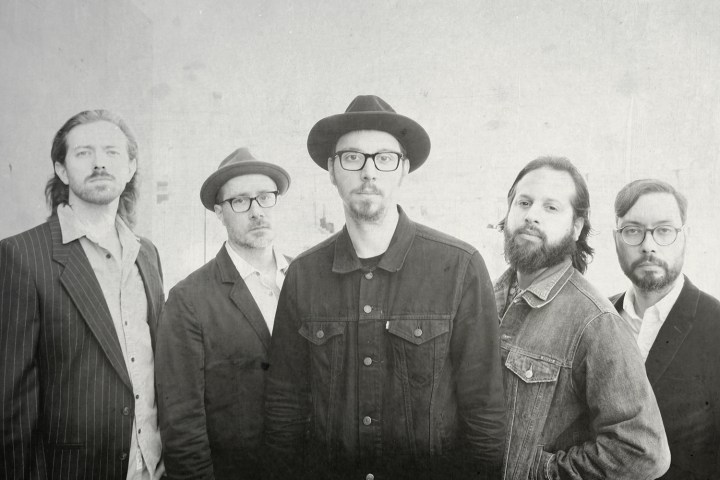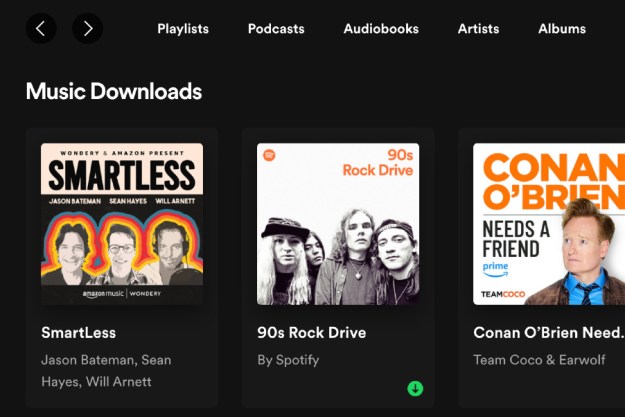
“It’s a good position for us to be in — to be able to put out music when we want and build an audience in all different ways.”
Mastering today’s music marketing paradigm is no easy task. Do you release a single, an EP, a full album, or what? Whether you like it or not, the answer is “all of the above.”
Fact is, today’s musicians need to be super-flexible about the ongoing and constant availability of their art — something the rootsy, Americana R&B collective known as Hollis Brown understand and embrace wholeheartedly.
In classic “give the people what they want” fashion, Hollis Brown —named after Bob Dylan’s stark 1964 folk-blues classic, Ballad of Hollis Brown — have plenty of aural ammo to choose from. This includes the current hit single Run Right to You, which gained further penetration when it became part of an Abercrombie & Fitch online ad campaign; Cluster of Pearls, a limited-edition vinyl EP tailor-made for last year’s Record Store Day that sold out so quickly it demanded a digital release just a few months later; and a full album titled 3 Shots . That last release includes Rain Dance, a song featuring the late guitar icon Bo Diddley, which got the band major traction when it was used in the trailer for the recent Michael Keaton-starring Ray Kroc biopic, The Founder.
Yep, that’s exactly how you do it right in the modern age.
Of course, all the marketing in the world don’t mean a thing if your music ain’t got that swing, but the good news is, Hollis Brown’s sound delivers on all cylinders.
“We’re a no-frills kind of band. There are no smoke and mirrors,” HB frontman Mike Montali explained to Digital Trends. “We’re reliant on the five of us playing together, live and kicking. We’re focused on writing the best material and getting to do the best songs — the ones that go the best way with our style and the sound we make together.”
Montali called Digital Trends from his Queens, New York homebase to discuss making music differently for vinyl releases, how to best respond to audience preferences, and turning influences into original ideas.
Digital Trends: Did you have a specific sound palette in mind for Cluster of Pearls because you knew it was originally intended only for a vinyl release?
Mike Montali: We did. We went to Nashville and recorded with Adam Landry [who’s also produced Deer Tick, Vanessa Carlton, Diamond Rugs, and Lilly Hiatt]. We recorded it live, analog, and direct to tape, just like an old vinyl record would have been made in the ’60s or ’70s — like a Creedence Clearwater Revival record, or something.
We definitely had the mindset to make it organic and have us all playing together. Even the vocals were recorded live. And since it was all live to tape, it wasn’t like we could go back. If there was a weird guitar thing in there, well, it had to stay. We couldn’t go back and overdub another guitar because it was all bleedthrough [i.e., multiple instruments appear together on the same track because the song was recorded live].
It made us a better band and put us on our toes a lot more. If we all had a great take but I had a bad vocal performance, everybody would have to go back and do it again. Nobody wanted to be the person holding up the ship, which was great. And doing it right to tape hopefully gave it a little more warmth.
And now we have different versions of that EP digitally on Spotify, iTunes, Soundcloud …
We didn’t even know it was ever going to be online, but you have to adjust and take how the audience wants to listen to music, you know what I mean? We just put it out there every way we can.
I think the vinyl revival has led to better listening habits and has gotten people to pay more attention to how a record flows and how good it sounds overall.
Yeah, definitely. It adds a different approach to the art of putting an album together. Streaming makes it more of a singles environment these days, which makes the industry feel like it’s almost going back to pre-Beatles.
You just read my mind. Until The Beatles introduced the concept of the album being an artform, it was more about the single of the week, and the album was an afterthought.
Yeah, exactly. We put Run Right to You out as a single recently and it’s doing well on its own, even though it’s not attached to an album of any kind. It’s really interesting, because a lot of radio people have been saying it’s rare that a single like this does so well without an attachment to any album — and there’s no announcement of any album for it, either.
For a lot of people now, everything is quick click-click-clicks, and they don’t want to sit around for an hour and listen to an entire record. They’ll put it on a playlist, or they’ll shuffle it where it comes up. Putting out Run Right to You as a standalone single is probably the best thing we’ve ever done in terms of success — it’s on the charts, at radio, in the Abercrombie & Fitch commercial, and it’s gotten onto some big playlists too.
It’s been an experience trying to see what works for us as a band. Most people go, “You’re a rock band? Oh, then we want to hear albums.” But the single is the thing that’s done the best for us, so we’re somewhere in the middle trying to figure it all out.
“Maybe releasing 12 singles over the course of a year is a better idea than just putting out one record that fades out right away.”
I look at singles as the gateway entry into a band. If I like what I hear with the first single, I might buy or check out the second one, and if I like that one too, then I may go all the way and figure the full album is worth the investment of my time, and my money. I’m now willing to pursue a fuller experience with your music.
Exactly — and it also adds shelf life. If you’re a band that puts out a collection of 12 songs and you do a quote-unquote “traditional campaign” — create an album cycle around it where, a month after you’ve dropped it, nobody really gives a shit. They’re already onto the next click, the next video, or the next viral thing.
Maybe releasing 12 singles over the course of a year or a year and a half might be a better idea than just putting one record out that garners some press right away, and then fades out. But it’s also situational, because it can depend on the type of band and artist you are.
You’re smart enough to service your audience’s needs in terms of however they want to get into your music.
That’s our mentality. Releasing new music is important. You get some bands that take four years in between their records. That’s never been our intention. We want to continuously have new releases every year, amassing a large collection of music.
It’s important for us to release new stuff. And fortunately — or unfortunately — when you do that, you have to go with the flow, and put it out as it comes. It might be as a single, or an EP, an album, or a double album. You do it however it comes through.
I want as much new material as I can get from my favorite artists, as often as they can provide it.
And you’ve got to be creative about it. It’s a good position for us to be in; to be able to put out music when we want and build an audience in all different ways. Younger people are responding to the single and the video, and how we license it. Our older audience likes that we put out the vinyl and the Record Store Day stuff, so it’s all working for us.
“The mindset is very different from EP to single to album, in terms of the cohesiveness and style of it all.”
And we’re just trying to be authentic with the sound too. Certain songs don’t necessarily fit with others — the recording styles, the ideas, and the lyrics. When you’re making a record, you might have 30 songs, and five of them you really really love, but they don’t fit with the cohesive idea of the album. You can’t really put them on there, so you put them out as singles. The mindset is very different from EP to single to album in terms of the cohesiveness and style of it all.
When we went in to cut Run Right to You, we recorded it while only thinking about that one song, and it sounded great to us. But when we were doing 3 Shots, we felt all of those songs were going to part of that one release. We wanted the vibe of that record to be cohesive from song to song, and we went into it with that mindset. It’s situation to situation, I think.
Run Right to You was a continuation of the Cold City sound [one of the best tracks on 3 Shots], which is the direction we’re going in — a little more R&B roots rock. Does that make sense?
Totally. I look at it like you guys have taken up that early J. Geils Band mantle, circa their early albums like J. Geils Band (1970) and Bloodshot (1973).
Oh, that’s cool. I’m going to have to go back and listen to those. We’re going to go more with that route on our next big release, I think — more upbeat rock with a more modern R&B, Temptations kind of feel. We’ve been an Americana band, which is niche music, but we’re also from New York City, so we have that natural edge that some other bands don’t have. We want to really dive into that and not shy away from it.
You guys do such a killer version of the blues classic Spoonful on 3 Shots that maybe it will get people to go check out the heavier Cream version [from 1966] as well as the original Howlin’ Wolf version [from 1960]. Me, I love all the surface noise and the harp [i.e., the harmonica] coming in on the right channel on your version.
So good! That one also features John McCauley from Deer Tick, who guests on the vocals. It was also done live, and I think we did two takes of it. At the end of it, it trails into a jam. That happened kind of coincidentally, because that’s how the tapes played. We already had that jam on tape, and we went back and recorded Spoonful over it. At the end of the song, the jam was still there, and the song naturally floated into it, so we said, “Let’s just keep it. It sounds kind of cool.”
Doing stuff like that is important for us to pay homage to the great American artists we were influenced by. We try to tip our hats to them while we’re still doing our thing. We want to be the act carrying on that legacy of American music where people care about the songwriting and playing your own instruments. That’s what’s important to us.
I’m down with that. You have to take your influences, put them into your own cauldron, and come out as Hollis Brown on the other side of it.
It’s something that’s forgotten about by a lot of bands. A band will come out with one record that has this unique sound, and that’s all that they do; they don’t go anywhere else. But we like to change, and I feel like we’ve changed our sound to get to where we are now. We’re a much better band for it. Now we want to write the best material possible for the next release.







